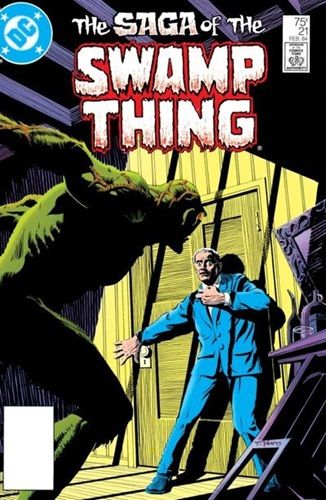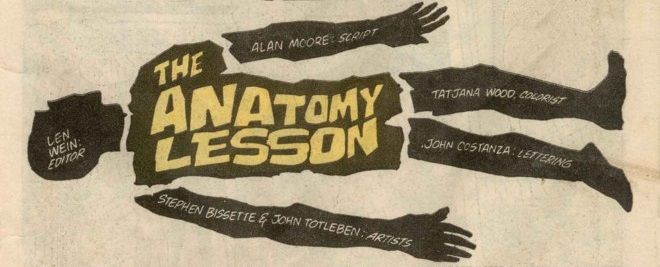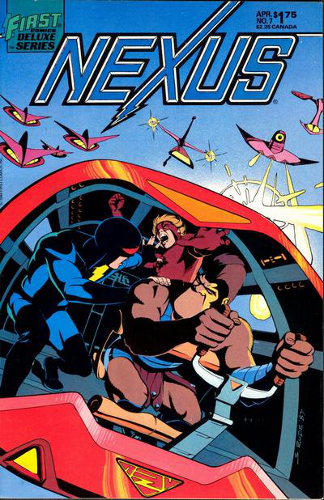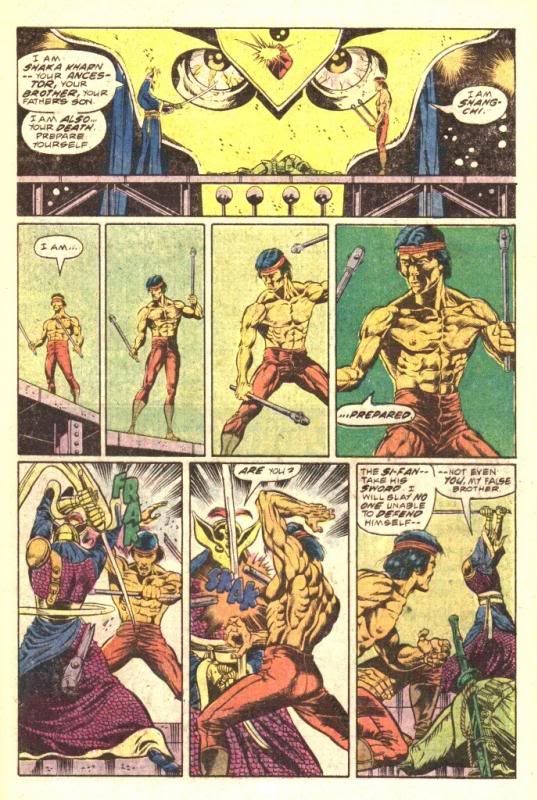|
|
Post by cattysquaw on Dec 18, 2014 23:06:47 GMT -5
Superman Batman #13

I really enjoyed the first run of this series, not so much the new run. The cover on this is wonderful art work by Michael Turner and it wraps up the Supergirl storyline. Wonder Woman is also involved and you get a Darkseid battle. The Jeph Loeb/Michael Turner teamwork on this is great. Superman/Batman is one of my favorite titles to this day. It was one of my favorites, wish they would have kept this form, not the new one, I read the first one in the new one and was greatly disappointed. |
|
|
|
Post by Paste Pot Paul on Dec 19, 2014 1:57:53 GMT -5
Superman/Batman is one of my favorite titles to this day. It was one of my favorites, wish they would have kept this form, not the new one, I read the first one in the new one and was greatly disappointed. Me too, love Jae Lee, but that book made no sense. |
|
|
|
Post by thwhtguardian on Dec 19, 2014 11:21:06 GMT -5
Superman/Batman is one of my favorite titles to this day. It was one of my favorites, wish they would have kept this form, not the new one, I read the first one in the new one and was greatly disappointed. It was one of my favorites, wish they would have kept this form, not the new one, I read the first one in the new one and was greatly disappointed. Me too, love Jae Lee, but that book made no sense. I don't know, I liked the first story where they met and then crossed over to Earth 2 but I dropped it shortly there after. |
|
Polar Bear
Full Member
Married, father of six
Posts: 107 
|
Post by Polar Bear on Dec 19, 2014 17:19:46 GMT -5
 Day Three: Conan #24, "The Song of Red Sonja," 1973. I was only three. It would take me years to discover Barry Windsor Smith, and years more to discover Barry Smith without the Windsor. And then, I'd find Conan. And dislike him as "boring" compared to all of the guys in costumes with super powers. I obviously don't think the same way now, since this comic made it onto my top 12 list. What a gorgeous comic book! A compelling pair of personalities, great storytelling, a done-in-one plot--everything you could ever want. My only complaint is that it was Smith's last issue, just as the pair reached their creative peak. Here's hoping we get a bit more Smith output over the next few years. |
|
|
|
Post by Calamas on Dec 19, 2014 18:53:09 GMT -5
  Saga of Swamp Thing #21 Feb 1984 “The Anatomy Lesson” Alan Moore Steve Bissette John Totleben This was different. At first I thought my reaction was related to what preceded it. I know Martin Pasko’s work on Swamp Thing is often considered his best. I was not a fan, essentially because I’ve never liked conspiracy stories and run-on stories; this was both. I kept reading because I liked the characters and, in those days, I still felt obligated to buy and read everything. Moore took over with #20 and even with having to clean up the remnants of Pasko’s story, I felt what Swamp Thing felt as he stomped through the marsh in search of Arcane’s body. And then came The Anatomy Lesson. Moore now free to do his own thing, I think it’s safe to say that everything changed. Not just a character, not just a title, but the face of American comics. I knew it as it happened, and to this day I remember that feeling. |
|
|
|
Post by Paste Pot Paul on Dec 19, 2014 19:49:22 GMT -5
  Saga of Swamp Thing #21 Feb 1984 “The Anatomy Lesson” Alan Moore Steve Bissette John Totleben This was different. At first I thought my reaction was related to what preceded it. I know Martin Pasko’s work on Swamp Thing is often considered his best. I was not a fan, essentially because I’ve never liked conspiracy stories and run-on stories; this was both. I kept reading because I liked the characters and, in those days, I still felt obligated to buy and read everything. Moore took over with #20 and even with having to clean up the remnants of Pasko’s story, I felt what Swamp Thing felt as he stomped through the marsh in search of Arcane’s body. And then came The Anatomy Lesson. Moore now free to do his own thing, I think it’s safe to say that everything changed. Not just a character, not just a title, but the face of American comics. I knew it as it happened, and to this day I remember that feeling. I remember feeling like that too, it was such a quantum shift in storytelling, and I think if you werent there in the 80s when it all happened, you will never quite "get" how it affected everything. Probably the closest modern examples may be Morrisons JLA, & Ellis's Authority for "widescreen" comics, or the current Image books(and other indy publishers too I have to admit) pushing truly excellent stories beyond the superhero genre. |
|
|
|
Post by Icctrombone on Dec 19, 2014 19:55:12 GMT -5
  Saga of Swamp Thing #21 Feb 1984 “The Anatomy Lesson” Alan Moore Steve Bissette John Totleben This was different. At first I thought my reaction was related to what preceded it. I know Martin Pasko’s work on Swamp Thing is often considered his best. I was not a fan, essentially because I’ve never liked conspiracy stories and run-on stories; this was both. I kept reading because I liked the characters and, in those days, I still felt obligated to buy and read everything. Moore took over with #20 and even with having to clean up the remnants of Pasko’s story, I felt what Swamp Thing felt as he stomped through the marsh in search of Arcane’s body. And then came The Anatomy Lesson. Moore now free to do his own thing, I think it’s safe to say that everything changed. Not just a character, not just a title, but the face of American comics. I knew it as it happened, and to this day I remember that feeling. I remember feeling like that too, it was such a quantum shift in storytelling, and I think if you werent there in the 80s when it all happened, you will never quite "get" how it affected everything. Probably the closest modern examples may be Morrisons JLA, & Ellis's Authority for "widescreen" comics, or the current Image books(and other indy publishers too I have to admit) pushing truly excellent stories beyond the superhero genre. I felt it too. Around the 3 parter with the Demon I think 26-28. It was greatness. |
|
|
|
Post by Paradox on Dec 20, 2014 3:10:22 GMT -5
10. Nexus #7 (First, April 1985) I loved the early '80s indy explosion, but most of all I loved First Comics. Not only did they come up with some great books on their own (American Flagg and Jon Sable, Freelance were early faves), they picked up other comics from defunct companies, like Grimjack coming from a back-up in Pacific's Starslayer and, the men of the hour, Capital's Nexus and Badger. I hadn't heard of either when I saw this in the shop. But the art on the cover looked great and First hadn't really steered me wrong yet, so I grabbed it. It was amazing. It was weird that it "started" with part two of a three-parter, but bad grocery store distribution in my youth had made me pretty adept at coming in in the middle of a story. If, indeed, this is a "story". I liked the way I was introduced here. I knew that this was taking place in world I knew nothing about, so the transition was made easier by the fact that they'd put the characters in a world they knew nothing about. It read like the old "y'know, if I locked these three characters in a closet, it would write itself" idea. These were very well-formed characters that didn't need their backgrounds and settings to make you "know" them. Half of it was philosophy, half of it was tongue-in-cheek almost Three Stooges like comedy, except for the slapstick. It was a weird and funny issue-long conversation, more or less, but it hooked me good. Later delving into the series let me know that Nexus' setting was just a deep and well-formed as he was, and before I knew it, I was peppering my speech with "What it is?"s, "Vootie!"s and "Great Goulesairan!"s with much satisfaction. I'd gotten the first First issue of Badger, too, but somehow he seemed a lot more fun in juxtaposition to the other two. His book got better as it went along, but never really reached the heights of Nexus. I still loved the Badger, though. You can count on that, Larry. 
|
|
|
|
Post by Reptisaurus! on Dec 20, 2014 19:25:30 GMT -5
Tales of the Beanworld # 21, 1993
"In the past there have been endless seasonal cycles... But this time around something basic went wrong - very wrong. And the Big·Big·Picture will never be the same!"
TotB is my favorite comic series and this is the first issue I owned.
21, specifically, is the classic comic book origin issue - The particulars don't matter that much, but let's just note that they're a lot more complex and inventive than a radioactive spider or blowed up planet - and what's special about this issue is how it ties into how Beanworld works.
Marder very slowly feeds us information about the "Beanworld" a layered, two-dimensional fantasy world that appears almost completely abstract at first glance but is actually based around rigorously logical formal rules.
Or, to put it another way, the point of reading Beanworld is to discover the true nature of reality. Issue # 21 fills in one small piece of the puzzle, revealing a little bit about the past and hinting at the future...
And then -with no prior warning - there wasn't another Beanworld comic for 16 years. Larry Marder went off to edit Spawn or somesuch crap. So my first issue was also the last.
|
|
|
|
Post by coke & comics on Dec 20, 2014 21:19:19 GMT -5
Tales of the Beanworld # 21, 1993 "In the past there have been endless seasonal cycles... But this time around something basic went wrong - very wrong. And the Big·Big·Picture will never be the same!" TotB is my favorite comic series and this is the first issue I owned. 21, specifically, is the classic comic book origin issue - The particulars don't matter that much, but let's just note that they're a lot more complex and inventive than a radioactive spider or blowed up planet - and what's special about this issue is how it ties into how Beanworld works.
Marder very slowly feeds us information about the "Beanworld" a layered, two-dimensional fantasy world that appears almost completely abstract at first glance but is actually based around rigorously logical formal rules. Or, to put it another way, the point of reading Beanworld is to discover the true nature of reality. Issue # 21 fills in one small piece of the puzzle, revealing a little bit about the past and hinting at the future... And then -with no prior warning - there wasn't another Beanworld comic for 16 years. Larry Marder went off to edit Spawn or somesuch crap. So my first issue was also the last. Tales of the Beanworld has been on my to-read list for years. Sounds like it's time to kick it to the top and rectify this terrible oversight in my comic reading. |
|
|
|
Post by Reptisaurus! on Dec 21, 2014 0:04:41 GMT -5
Tales of the Beanworld # 21, 1993 "In the past there have been endless seasonal cycles... But this time around something basic went wrong - very wrong. And the Big·Big·Picture will never be the same!" TotB is my favorite comic series and this is the first issue I owned. 21, specifically, is the classic comic book origin issue - The particulars don't matter that much, but let's just note that they're a lot more complex and inventive than a radioactive spider or blowed up planet - and what's special about this issue is how it ties into how Beanworld works.
Marder very slowly feeds us information about the "Beanworld" a layered, two-dimensional fantasy world that appears almost completely abstract at first glance but is actually based around rigorously logical formal rules. Or, to put it another way, the point of reading Beanworld is to discover the true nature of reality. Issue # 21 fills in one small piece of the puzzle, revealing a little bit about the past and hinting at the future... And then -with no prior warning - there wasn't another Beanworld comic for 16 years. Larry Marder went off to edit Spawn or somesuch crap. So my first issue was also the last. Tales of the Beanworld has been on my to-read list for years. Sounds like it's time to kick it to the top and rectify this terrible oversight in my comic reading. I love it so much - It really is like nothing else I've ever read, and itt's got such depth of theme, dealing with the nature of reality and spiritual existence 'an stuff... and at the same time it's totally accesable to bright six year olds. |
|
|
|
Post by berkley on Dec 23, 2014 3:21:35 GMT -5
Master of Kung Fu #49: The Affair of the Agent who DiedNovember 1976 (cover date Feb 1977)  This was my first issue of MoKF. I had been getting back into comics for over a year, and after a few months of mostly checking out old favourites like ToD, the Avengers, etc, was slowly discovering some of the new series that I'd never heard of before. I'd seen MoKF advertised in other Marvel comics, but the covers often weren't very good and I felt some suspicion that it might be nothing more than a cheap attempt to cash in on the martial arts fad that was pretty big at the time. All those doubts ere laid to rest as soon as I opened this one up and got an eyeful of Paul Gulacy's incredible artwork. And after getting it home and reading it, I was kicking myself that I hadn't been following this series all along. Even though I'd never read a single panel of the series before and #49 was a late instalment of a long, multi-part story, Moench's writing somehow had me feeling as involved with these characters and their story as if I'd been reading it all my life. I've rarely felt as emotionally drained at the end of a comic as I did after reading this one. And Gulacy's artwork was something else. I'd never seen a fight scene in comics or elsewhere that dared to create drama and tension by slowing everything down before the kinetic mayhem ensued. And since at this point in my life I had only heard about the Bruce Lee films, but had never been able to see one (too young to get into the theatre when they came around our town), pages like this felt like a revelation:  MoKF instantly became one of my favourite series and I followed it to the end, even though Gulacy only had one more issue to go before he left.
|
|
|
|
Post by Paste Pot Paul on Dec 23, 2014 3:37:40 GMT -5
Master of Kung Fu #49: The Affair of the Agent who DiedNovember 1976 (cover date Feb 1977)  This was my first issue of MoKF. I had been getting back into comics for over a year, and after a few months of mostly checking out old favourites like ToD, the Avengers, etc, was slowly discovering some of the new series that I'd never heard of before. I'd seen MoKF advertised in other Marvel comics, but the covers often weren't very good and I felt some suspicion that it might be nothing more than a cheap attempt to cash in on the martial arts fad that was pretty big at the time. All those doubts ere laid to rest as soon as I opened this one up and got an eyeful of Paul Gulacy's incredible artwork. And after getting it home and reading it, I was kicking myself that I hadn't been following this series all along. Even though I'd never read a single panel of the series before and #49 was a late instalment of a long, multi-part story, Moench's writing somehow had me feeling as involved with these characters and their story as if I'd been reading it all my life. I've rarely felt as emotionally drained at the end of a comic as I did after reading this one. And Gulacy's artwork was something else. I'd never seen a fight scene in comics or elsewhere that dared to create drama and tension by slowing everything down before the kinetic mayhem ensued. And since at this point in my life I had only heard about the Bruce Lee films, but had never been able to see one (too young to get into the theatre when they came around our town), pages like this felt like a revelation:  MoKF instantly became one of my favourite series and I followed it to the end, even though Gulacy only had one more issue to go before he left. Mate I loved MOKF, I came in later than this with Zeck and the late Gene Day(R.I.P.) but stayed til the bitter end. Was never able to get many older issues, maybe 20 or so, but there were a few Gulacy among them. Genius. This was my first.  |
|
|
|
Post by berkley on Dec 23, 2014 10:09:43 GMT -5
Master of Kung Fu #49: The Affair of the Agent who DiedNovember 1976 (cover date Feb 1977) Mate I loved MOKF, I came in later than this with Zeck and the late Gene Day(R.I.P.) but stayed til the bitter end. Was never able to get many older issues, maybe 20 or so, but there were a few Gulacy among them. Genius. This was my first.  The artwork was really erratic for a long time after Gulacy left, and it wasn't until Mike Zeck came on board that the artwork started to be a match for Moench's writing again in quality, especially once Gene Day took over as regular inker (and later on as artist). |
|
|
|
Post by Paste Pot Paul on Dec 23, 2014 13:43:10 GMT -5
The artwork was really erratic for a long time after Gulacy left, and it wasn't until Mike Zeck came on board that the artwork started to be a match for Moench's writing again in quality, especially once Gene Day took over as regular inker (and later on as artist). I read the cover off that book, you're right about the art, one of the big disappointments with back issues on this title was the wildly varying quality of artist, but who can blame them..."we want you to follow Paul Gulacy"... As for Gene Day, the first artist to blow me away with page design, obviously I would go on to discover Steranko, Kirby, and much later JH Williams III. He was a massive loss to us. |
|